Seasons – Winter 2017
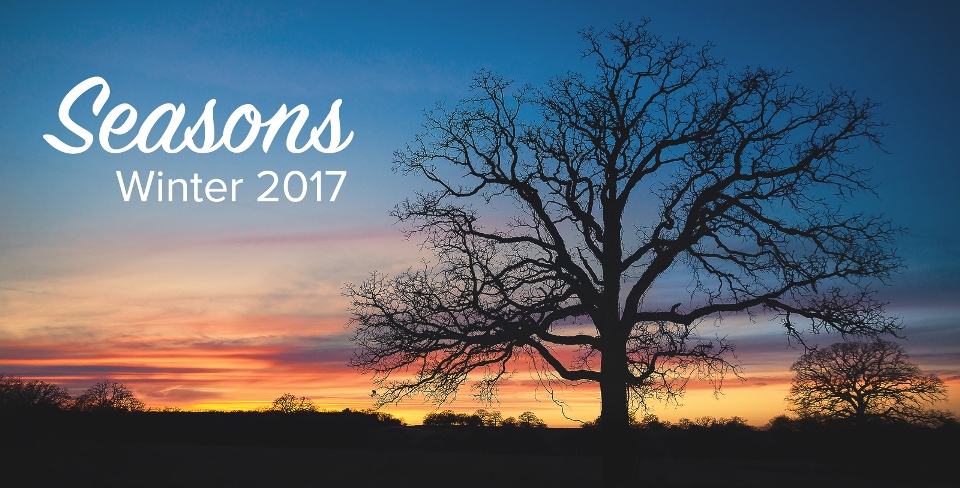
From the Plateau Land & Wildlife Management Team,
Another great season is upon us and we’ve finally gotten a little taste of Winter to lift our spirits and put us in a jolly mood for the upcoming Holidays. This time of year is full of joy, celebration, and for most of us, spending time outdoors with family, friends, and wildlife. We’re happy to celebrate another year in review. It’s been a great year here at Plateau and in this issue, we look forward to sharing some of our successes with you all – we have a lot to be grateful for. Our wonderful clients and landowners and the land they let us help care for make doing what we do some of the most rewarding work we believe there is.
In this issue of Seasons, you’ll find great articles and content from some of our folks. There’s sure to be something in here of interest to everyone. Enjoy this issue and we hope you gain something from it. Our goal is to help you with the care and enjoyment of your land and to make land ownership more rewarding for you and the wildlife who live there.
So, as you tie your final ribbons on gifts, and your thoughts are on another year coming to a close, be sure to add taking care of your land to the list of those things you did right this year – because an investment in the enjoyment of your land, and the heritage of land ownership is something that will be around for many more years to come!
Happy holidays to you and yours.
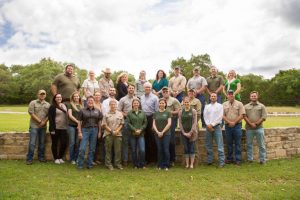 Until next season and Seasons,
Until next season and Seasons,
The Plateau Team
Table of Contents
Road to 400
Winter Wildlife Management Activities Checklist
Highlighting a Wildlife Management Property
A Year in the Field
Titmouse Research Project – Volunteers Needed
Introducing Glenda Beasley & Lanette Patterson
Service Spotlight: Site Monitoring Visit
‘Tis the Season to Start Talking
What is Your Property Worth?
Plateau Land Group Featured Listing
Road to 400
By James Hall, Staff Biologist II
One of the most remarkable aspects of Texas is its vastness and the diverse ecoregions that are found within. Beginning in the Austin area, in half a day and two gas station stops (depending on your constitution), you can reach the far east Texas pine forests, coastal beaches and prairies, south Texas shrublands and sub-tropics, northern cross timbers, high plains of the panhandle, or the dry deserts and mountains of the Trans-Pecos. This is not including the drive back, of course. As Plateau biologists and avid birders, Mark Gray and I have the opportunity to travel to some of these unique regions during service to our landowners. We also have a fanatical interest in the flora and fauna that occupies the land and have the desire to grow in our knowledge base and skills so that we may serve our customers, as well as better promote the ideals of conserving the state’s natural resources. As a result, Mark coerced me into engaging in a new challenge that neither of us had previously attempted and would require an entire year to accomplish. Assuming we could obtain permission from our wives to be absent-minded birders for the year, our goal was to observe 400 unique bird species in Texas in 2017.
This goal is known as a “Big Year,” a term used by birders when they are attempting to see as many birds as possible in a year, within a given area. Admittedly, a Big Year is somewhat of a personal endeavor rather than a professional one, but it does offer us the opportunity to travel and practice our naturalist skills. And boy does it require some travel. When Mark first approached me near the beginning of the year with this idea, I chuckled and thought, “Sure, let’s do that.” Internally, it sounded like a fine idea, but not something I would have time for and would likely fizzle out by the time we finished with Plateau’s breeding bird survey season in late June. By mid-January I had already spent some time hiking some of the parks in the Austin area, conducting some backyard birding in Cedar Park, and recording all the birds I was observing. My online checklist on the handy eBird website indicated that I was already over 100 species by January 18th. Maybe a Big Year is possible? Maybe I can convince my wife that this can be my birthday AND Christmas present?
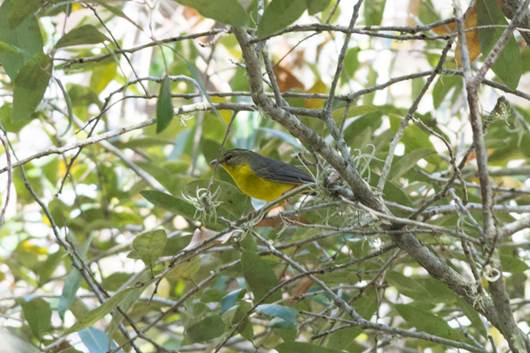
Golden-crowned Warbler (144) – Photo courtesy of Colton Robbins
By the end of January, with my motivation moderate, I had birded several hotspots in Travis, Williamson, Hays, Burnet, and Llano counties on my way to 139 species, and Mark was doing the same. He caught wind of a relatively uncommon bird known as a Golden-crowned Warbler (species number 144) in a small park in Refugio, TX, and we took our first long trip to chase it down, swinging along the coast shortly thereafter. Leaving Mark’s house before dawn and returning bleary-eyed at dusk, we had picked up some really interesting species including a trio of the endangered Whooping Crane (165) in Rockport, and a phantom-like Short-eared Owl (168) in Gonzales during our return.
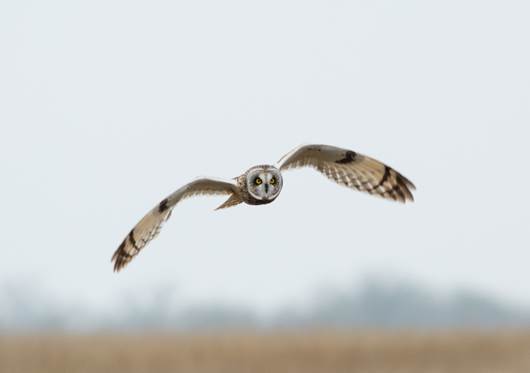
Short-eared Owl (168) – Photo courtesy of Colton Robbins
By April, several east Texas trips resulted in some interesting birds, including a Prothonotary Warbler (229). A handful of coastal trips in late April and early May (both for work and pleasure) resulted in a big bump in species, up to 315 by the end. This period of time is the peak of migration when a vast number of species are moving across the Gulf or along the coast towards their northern breeding grounds. Luckily for birders, Texas is a rest area for birds during this time. When a strong front blows across the state during migration, exhausted birds who have been fighting the winds and distances require recuperation in coastal woodlands before continuing their journey – a term aptly known as bird “fallout.” Birding destinations such as High Island, east of Houston, is an outstanding migration location to search for warblers, vireos, thrushes, orioles, and flycatchers. And the nearby beaches, bays, and coastal marshes found at Anahuac National Wildlife Refuge are home to hundreds of waterfowl, shorebird, and other species.
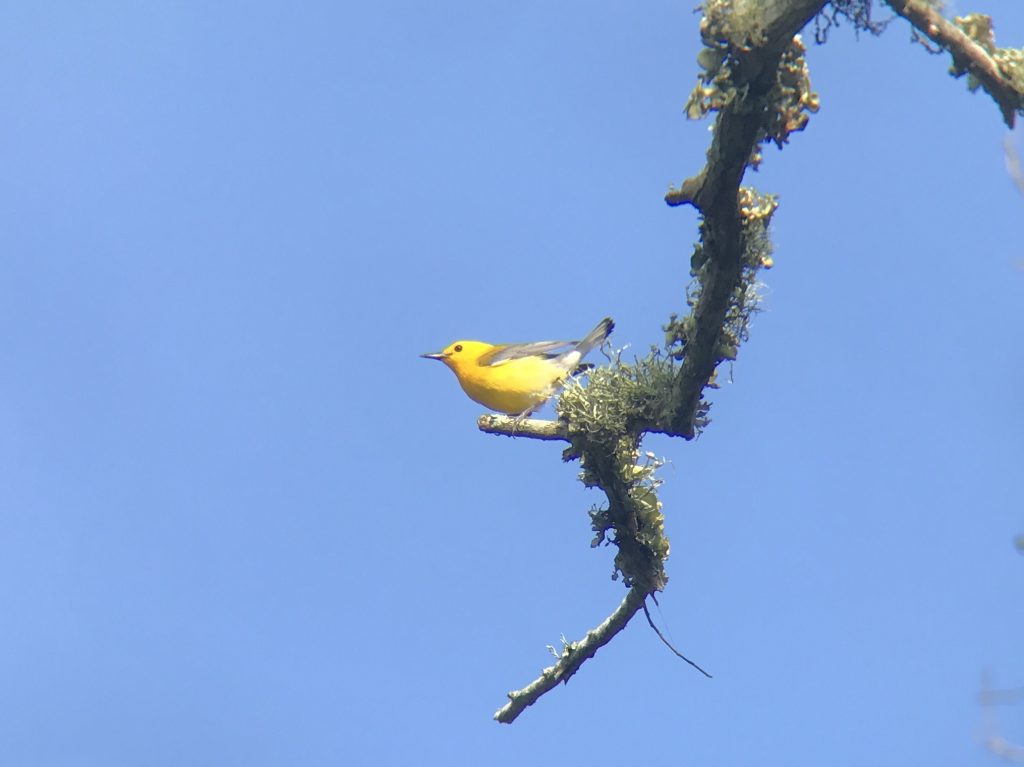
Prothonotary Warbler (229)
Mid-May is approaching and Mark and I are ourselves in need of recuperation as we have just completed Plateau’s busiest time of the year – yet there is so much more to see. As previously mentioned the state is huge, and the grand diversity contained within its borders make a Big Year achievable. However, the state is huge! Our next plan was to make a short overnight trip to the Trans-Pecos and visit the Davis Mountains. The countryside in that area is gorgeous. As you ascend the mountains, you transition from the dry desert into the high conifer forest. These areas found in the Davis Mountains, Big Bend National Park to the south, and the Guadalupe Mountains to the northwest are known as “Sky Islands” due to their isolation atop the ranges, enveloped by radically different lowlands. When venturing through this remarkable landscape, you can immediately understand why the flora and fauna are so unique in these areas. Our trip was successful, and one of the most exciting birds observed was the Montezuma Quail (324), also known as Fool’s Quail. I am sure we were acting like fools upon encountering this new bird. After returning home and reviewing my personal year-to-date list (341, May 20th), I realized I have seen far more birds this year than any other. Again, my motivation was in the stratosphere.
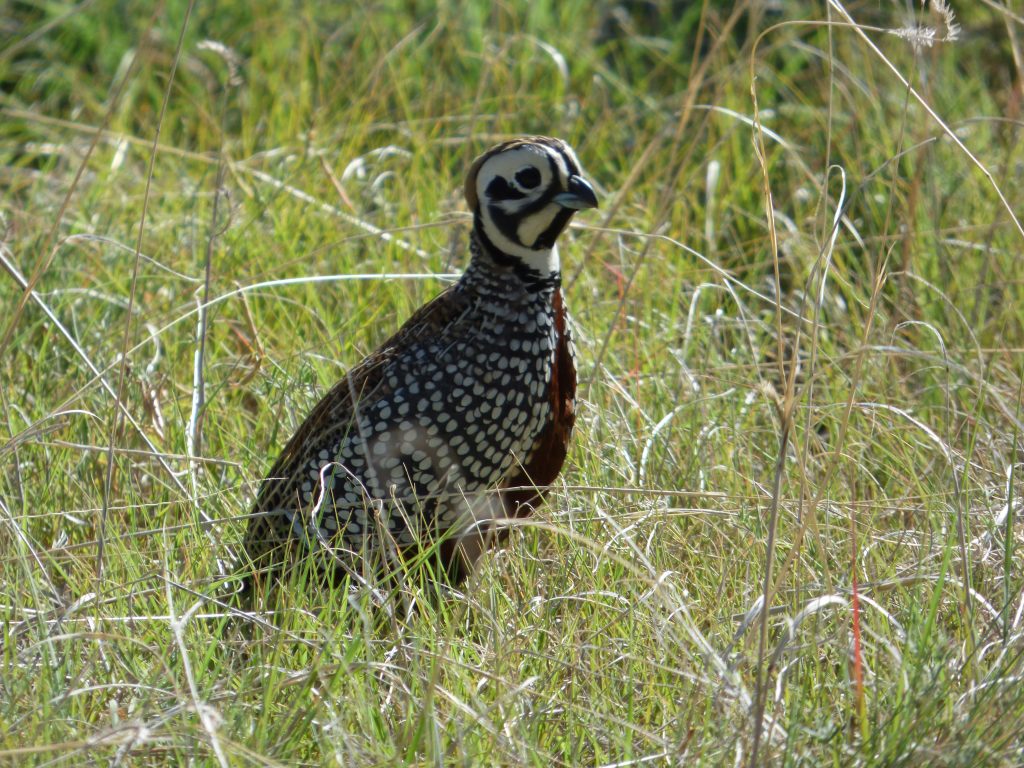
Montezuma Quail (324) – Photo courtesy of Romey Swanson
Over the next three months, we will have exhausted our ability to find any common or typical birds in the central Texas region and will rely almost exclusively on long distance trips. Additionally, despite their love and support, we had to endure an assortment of eye rolls, sighs, and looks of confusion from our friends and family as we attempt to explain how many birds we have left, where our next trip will take us, and other random bird lore.
From June to August, Mark and I each separately took trips to Choke Canyon, Big Bend, the Guadalupe Mountains, and various parks and birding hotspots in the area, soaking up anything we could find. At one point, a variety of terns, gulls, frigatebirds, and a seabird called a Long-tailed Jaeger (377) blew in to the Austin area, which was an exciting and unique experience for the central Texas birding community. We each picked these up on our lists. My two-night camping trip towards the latter half of November to the Guadalupe Mountain “sky islands” brought me to 386, despite the extreme wind gusts and freezing nights. I delighted in watching mule deer and javelina confidentially saunter across the range, but I was not able to uncover any snakes – I am not just a bird nerd.
At this point, only the last week of November and the month of December remained in 2017, which seems like a long time when hovering in the upper 380s, but required the biggest and arguably the most exhausting push to find those last few species. Mark and I adventured to the Rio Grande Valley for a one-night trip to visit South Padre Island and the Brownsville area. The numerous unique parks and wildlife refuges in this region allow for a wide variety of sub-tropic species, found nowhere else in Texas. Birding in this part of the state is world-renown. With temperatures in the high 80s, and 500% humidity, the stark climate contrast from the west Texas mountains to the Valley was not only shocking but also tiring. Following reports from other birders, we visited the Brownsville City Landfill (yes, a trash dump) to find the rare Tamaulipas Crow (yes, a crow at a trash dump). Yes, this part of the story elicited more glazed eyes and looks of concern from our friends and family.
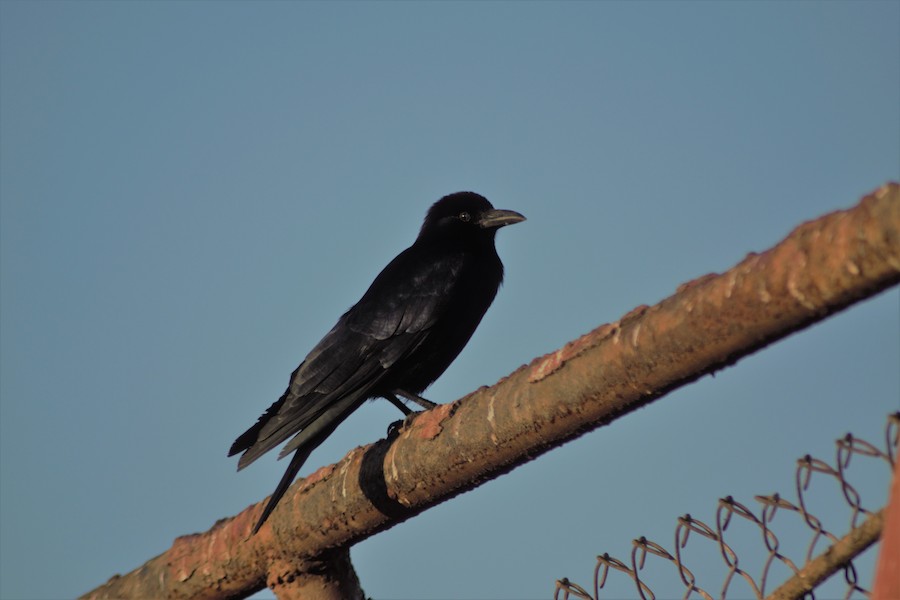
Tamaulipas Crow (396)
At long last, we were both within 4-5 or so away from 400, and we can now taste it (having washed away the taste of the landfill). The only region of the state that neither of us had ventured was the high plains of the Texas panhandle, home to an assortment hawks, falcons, migrating geese, and other species. We took one final trip. In our delirium and excitement, our conversations along the road resorted to mostly inappropriate jokes and ramblings about our favorite music from Junior High. Regardless, within a few hours of pulling into the beautiful metropolis of Lubbock, I hit my 400th bird, in the form of a large group of Cackling Geese in a small city park. Shortly thereafter, a Rough-legged Hawk became Mark’s 400th bird. We birded the rest of the afternoon and the next morning, each picking up a couple more species for our lists.

Cackling Goose (400)
We did not tally up our cumulative mileage, nor did we add up our time spent in a car, sitting at a bird blind, or hiking a trail. We probably would be shocked and appalled by some of these figures, but undoubtedly proud of ourselves. There are thousands of birders each year who participate in Big Years and report their findings on eBird. Whether you look at birding as a fool’s pleasure or a lifelong passion, you cannot deny that this great state is worth exploring and sharing. The observations collected by naturalists on eBird is one of the largest collections of biodiversity data in the world, contributing to the study of birds, and providing useful information for land managers, ornithologists, and conservationists.
Upon reflection of this trip, I recognize that some of the observations we collected may be useful someday. I also recognize that carrying binoculars in a park appears creepy to the average citizen. While I don’t plan on participating in a Big Year anytime in the near future, the journey was fantastic, and I implore birders and non-birders alike to step outside and look around. You never know what you may find.
Back to TopBack to Top
Winter Wildlife Management Activity Checklist
By Kameron Bain, Business Development Manager
The New Year is right around the corner and it’s time to start thinking about your 2018 Wildlife Management Activities. For many landowners, it is important to get off to a good start, and as you can see, there are a lot of activities for you to do just that:
- Wintering and Resident Bird Survey (WRBS) – We are currently finishing these up for the season, but still have some room to fit in a few more before February 15. Schedule yours today!
- Nest Boxes – Check and clean these out before the upcoming breeding bird season
- Imported Red Fire Ant Control
- Brush Management – Needs to be done before the breeding bird season, which begins in early March
- Spring Breeding Bird Surveys – Begins March 17
- Camera Surveys – Post-hunting season is a good time for this activity
- Feral Hog Control – Late winter through spring is an ideal time to reduce feral hog numbers prior to spring nesting/fawning
- Strip mowing and Discing – Best conducted up until late February
- Tree Trimming – Not a qualifying activity, but this is the time of year to do it
- Tree and shrub planting – This is the best time of year to plant woody plants
Highlighting a Wildlife Management Property
By Sarah Kahlich, AWB ®, Senior Wildlife Biologist
One of the joys of being a wildlife biologist is being able to visit numerous landowners’ property each year. It is always exciting to visit a property for a 5-year wildlife management plan update and see how a landowner is currently managing their property and how wildlife management has changed the habitat over a 5-year time period.
I recently conducted a site visit, a service to tour your property with a Plateau biologist and examine the unique ecological and habitat characteristics of your land, on Mr. and Mrs. Brittain’s property in Kerr County. The last time Plateau had visited the property was in 2013 with a different biologist conducting the site visit. During the 2013 site visit, the property had high numbers of blackbuck antelopes and axis deer. Since that site visit, all of these exotics had been removed.
During my recent site visit, Mr. Brittain mentioned how bad the property looked and how there were hardly any grasses because of the exotics. During any of my site visits, I take habitat representative photos of the property, though this time when I went back to the office, I decided to look at the old photos from the 2013 visit. The changes over the last 5 years were amazing. Looking at side-by-side photos from 2013 and 2017, it is extremely noticeable that the removal of exotics was one of many beneficial moves on the landowner’s part.
Below are some side-by-side comparisons, a few in the exact location and other in the same area.
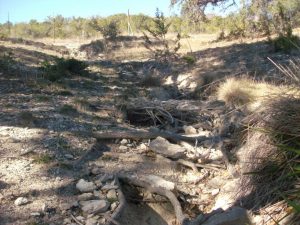
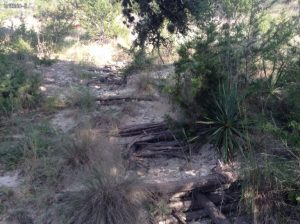
Erosion occurring from water moving from higher elevations to lower elevations in 2013 and the same area with cut juniper logs installed in 2017.
In 2013, this area was mostly barren with a few small juniper and sprigs of grass. In addition to the cut juniper limbs, Mr. Brittain will also build slash dams out of cut juniper and these will be placed between each section of the juniper limbs to help diffuse more water. There is a noticeable difference in the reduction in erosion and backfill was starting to occur, but also look at the higher density of vegetation in 2017.
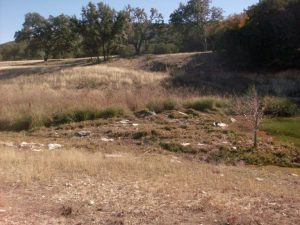
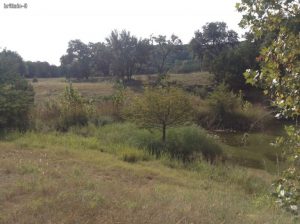
Riparian management is extremely important – these areas can be more sensitive then we realize. Some landowners who are lucky enough to have year-round water flowing through their property tend to mow right up to the water’s edge. By leaving a natural buffer (5-10 feet or more) from the water edge, you are reducing the potential for heavy erosion loss during a large rain event and helping to increase the amount of water absorbed into the soil. In 2013, the area below a small dam was maintained by mowing. In the last 5 years, the mowing has stopped and the number of riparian vegetation has dramatically increased. The density of soil-stabilizing vegetation such bald cypress, sycamore, bushy bluestem, buttonbush, Eastern gamagrass, cedar elm, have returned.
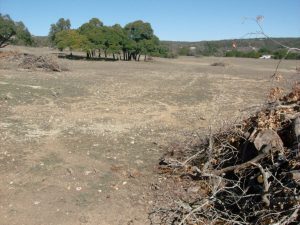
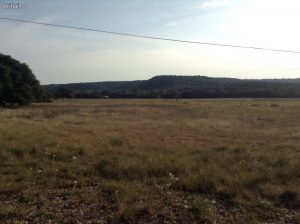
In 2013, there were numerous exotics roaming the property. After removing exotics and only leaving native white-tailed deer, the grasses and forbs were allowed to rest from constant grazing pressure. In 2017, the herbaceous cover is high in density and diversity. White-tailed deer were observed running through the oak mottes and across this large field as we drove around.
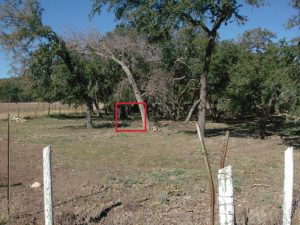
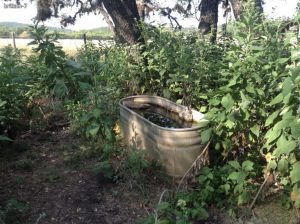
With grazing pressure reduced, forbs like frostweed were able to rebound. The 2013 photo (water trough in the red box) there were no forbs or shrubs growing under the oak motte. In 2017, the water trough is surrounded by frostweed growing dense under the oak motte. Not seen in the 2017 photo is cow pen daisy stands growing under this oak motte as well.
With a little time and proper management, Mr. Brittain’s property slowly started to return to a more natural state. The list of vegetation for his property has increased greatly and the density of the vegetation has as well. More native grasses were observed and the recruitment of oak and other woody species is beginning to occur.
It is quite amazing to see how a once heavily grazed property has rebounded to a more natural looking state through the removal of ungulates who are constantly grazing. Grasses and forbs have had a chance to rest, and shrubs and new oak trees, cedar elm, and hackberry trees can finally grow taller than 5-6 inches. New trees that are found have been protected from the white-tailed deer that utilize the property by caging around them. The shrub layer under and around trees has increased and are relatively dense in some areas, which provides excellent shelter for a wide array of wildlife. Making small adjustments to the way you manage your property can go a long, long way. Sure, it might take a few months or a year and timely rains to notice the change, but slowly and surely your property will start to transform.
Back to TopBack to Top
A Year in the Field
By Nick Fisher, Wildlife Services Technician
“Tea-kettle, tea-kettle, tea-kettle,” the chorus of a Carolina wren pierced the brisk air on a Texas winter morning accompanied by the crunch of a nearly frozen bluestem under my hiking boots on my first solo site visit. The combination was overwhelmingly melodious after working nine years under the fluorescent lights of a local H-E-B. I took a deep metal-tasting breath that I felt travel deep into my lungs, looked around at the surrounding oak mottes and open fields of native grasses, and couldn’t help but let a smile slip through; I had made it. This was monumental for me – rescuing bats from warerooms and relocating grackles that found their way into the grocery stores I worked at was not exactly the wildlife experience I was searching for after receiving my Bachelors in Wildlife Biology.
I grew up constantly being outside and anyone who knew me prior to Plateau already knew I was destined to work outdoors. I climbed the corporate ladder with the grocery store chain where I felt completely comfortable providing customer service daily and ensured the store was constantly exceeding expectations, but I knew it wasn’t where I wanted to be. My first few months with Plateau I became used to putting in 10 hour work days with miles of trekking through the luxurious landscapes of the rocky, juniper-covered hill country.
I found myself realizing (again) the necessity of the wilderness to the human spirit (and the vitality of water) as Edward Abbey once taught us in Desert Solitaire. I was at home in the field and finished each day with a sense of accomplishment – something I wasn’t used to after years of straightening products on shelves that would be entirely disarranged just minutes afterward.
During the blur of the past 11 and a half months, I picked up on a few things that could potentially be important for my health. I learned that assassin paper wasps protecting a hidden nest in a nest box will be present at each box you forget to bring your wasp spray to. I learned looking down at the rocky terrain may save your ankles, but leaves you vulnerable to an unforgiving Orb Weaver’s web to the face. Most importantly, between checking my first bird nest box and now, I learned this is where I will make a difference in the world. Passion for wildlife and that same desire to make a difference in the natural world has brought me to Plateau where I have the opportunity to share my passion while delivering a relentless commitment to customer service with private landowners in search of protecting, preserving and enhancing their land.
I’ve heard that separation is in the preparation, and preparing for a day in the field in Texas may require more than you realize. In one day in Texas, I’m convinced it’s possible to suffer from dehydration, sunburn, ticks, splinters, athletes foot, heat exhaustion, wasp sting, chiggers, poison ivy, muscle cramps, tired eyes, blisters, ant bites, and numb extremities on the two cold weeks Texas gets. These obviously don’t all occur each day but should be prepared for.
Wearing the right clothes and watching the weather can prepare you for most of these things, but some things just can’t be prevented. Torrential downpours that start midway through the site visit of a fifty plus acre property are difficult to be prepared for, as well as finding yourself halfway through a property and emerging into a prickly pear smothered landscape. However, getting rained on and a cactus spine in the leg are like an unspoken initiation for a technician, along with maneuvering through some Golden-cheeked warbler habitat to check some virtually inaccessible nest boxes that were installed years before the juniper took over.
I learned that pants, shoes, and undershirts must be of a specific configuration of thickness, breathability, protectiveness, and waterproof that resembles the Fundamental Theorem of Calculus. Wearing your most breathable pair of pants (and thinnest) is like asking for a botany lesson on the spiny plants of Texas not limited to greenbrier, mesquite, huisache, buckthorn, agarita, cat-claw acacia, and over 100 species of cacti that reside in Texas. Likewise, wearing your most protective and thickest pair of pants will make a 98-degree day feel more like 150 as you zig and zag across an open field spot treating for invasive red fire ants with the direct sunlight beaming down on you like a kid with a magnifying glass.
Although I’m not sure if actually a disorder, my eyes possess photophobic traits that restrict me from leaving the comfort of my home without a pair of shades. I realize now the blessing in disguise of this disorder. While providing the comfort necessary for me to step into the sun, I soon began to notice the branches, dust, and small flying insects that all seem to aim for the pupil of an unsuspecting technician not wearing eye protection.
At this point, you may be questioning how one could call this a “dream job.” Honestly, at the end of the day I don’t remember the glochids that protruded through my pants and disappeared into my skin, or the ants that crawled into my boots and lit my ankles on fire, or the sun’s lethal rays that dodged every cloud in the sky all day long searing my pale skin to a lobster hue the time I forget to reapply sunscreen.
What I do remember was the sunrise that colored the sky as I started my day miles outside the city limits in a juniper forest with the call of a Golden-cheeked warbler cutting through the crisp air. I remember the excitement in the voice of a landowner that witnessed the turkeys on his property for the first time after installing a platform feeder. I remember the five hungry little heads of baby bluebirds in a bluebird nest box impatiently awaiting the arrival of a parent with some grubs as I checked the grass-filled box.
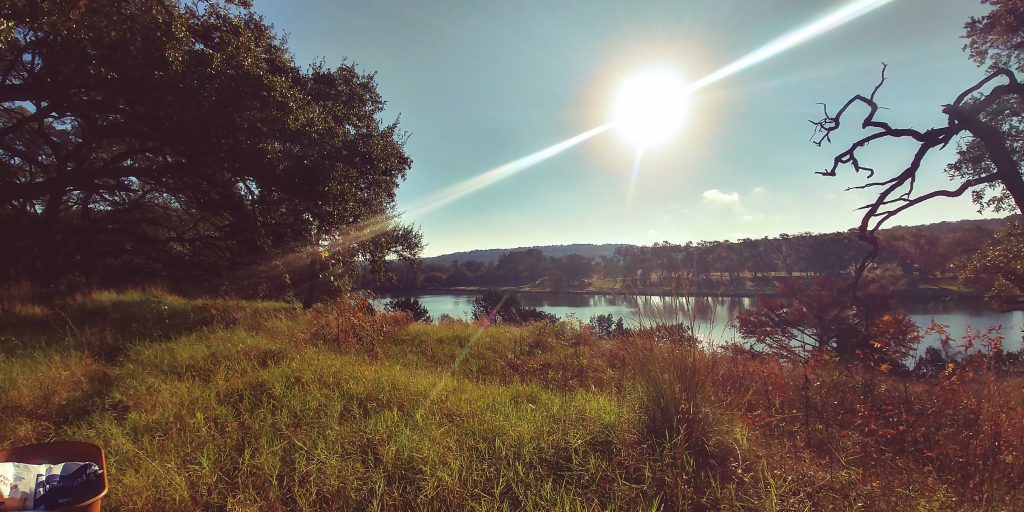
Once the muscle aches wear off and the blisters turn into calluses from days of chainsawing, all that remains is the mosaic of oak trees and Mexican persimmon that were beginning to disappear behind the encroaching ashe juniper trees no longer in a fire-driven natural balance. The game trails that disperse in all directions from a water table during a dry spell is rewarding enough to erase the memories of the heat exhaustion after installing three 305 gallon water tables, two platform wild bird feeders and 42 nest boxes in the middle of a summer day.
Almost a year has passed since I started this journey as a Wildlife Services Technician. I’ve transected dozens of times over the same ground, but each day is a new adventure and no two days have been the same. The hair-standing chills courtesy of a threatening diamond-backed rattlesnake can be recreated, but the snake won’t be seen in that same location on the next site visit – even though you will remember exactly where your boots were in relation to the strike zone. The antlers of a solid ten point buck that flaunts its impressive tines nightly on a remote camera wildlife survey, creating hundreds of photos, will only be more impressive the next time I see him – if he makes it another season. Searching through thousands of images containing common North American large mammals doesn’t sound too exciting, but realizing the numbers of megafauna on a property being managed responsibly is. Checking nest boxes for hours a day can be tedious, but measuring the nesting activity success rate on a highly active property that previously did not provide supplemental shelter is rewarding on its own. Likewise, trudging through a densely covered field searching for ant mounds isn’t the best of times, but hearing a quail covey call on a cool fall morning on a property that you performed fire ant treatment on makes every mile worth it.
Each action of a technician is assisting landowners in improving their land and helping to ensure there is a natural world for the next generation to enjoy, and that alone carries a bonus you can’t get working at a grocery store.
Back to TopBack to Top
Titmouse Research Project – Volunteers Needed
Rebekah Rylander, Ph.D. student from Texas State University, is looking for volunteers to help with her dissertation research! Rylander is studying social flocking dynamics and population genetics of the black-crested titmouse, a common residential songbird found in the Texas Hill Country. In order to do this, she utilizes nestboxes, a form of artificial cavity that the titmice often use in the spring to raise their young. Once the titmice establish a home and begin feeding nestlings, Rylander is able to safely capture and place color-bands on each family member’s legs, giving all birds a unique combination of colors that can be seen through binoculars during focal observations. This then allows any observer to monitor the titmice from a distance while also collecting data on what family members are still in a flock throughout the year.
By following color-banded birds throughout her Master’s degree, Rylander discovered that titmice tend to have strong family ties, where the heaviest son usually remains near his mother and father instead of dispersing like most young do. This behavior, known as limited dispersal, eventually leads to the son inheriting part of his father’s territory the following year. Thus over time, multiple related titmice may be residing next to one another in kin-structured neighborhoods, helping relatives defend territories and find food during cold months.
Rylander is continuing her research on titmouse behavior and genetics and is looking for volunteers interested in her work! She needs landowners who currently have nestboxes on their property and who would be willing to check the nestboxes once a week during the months of March-May. If a bird begins to build a nest, a picture of the nest will be sufficient for Rylander to know if it’s a black-crested titmouse or not. If it turns out to be a titmouse, Rylander will ask to visit your property to color-band the nestlings and/or take a small blood sample for genetics work.
Those interested in participating, please email Rebekah Rylander at [email protected]. She appreciates any and all nature enthusiasts who enjoy getting their hands a little dirty for science!


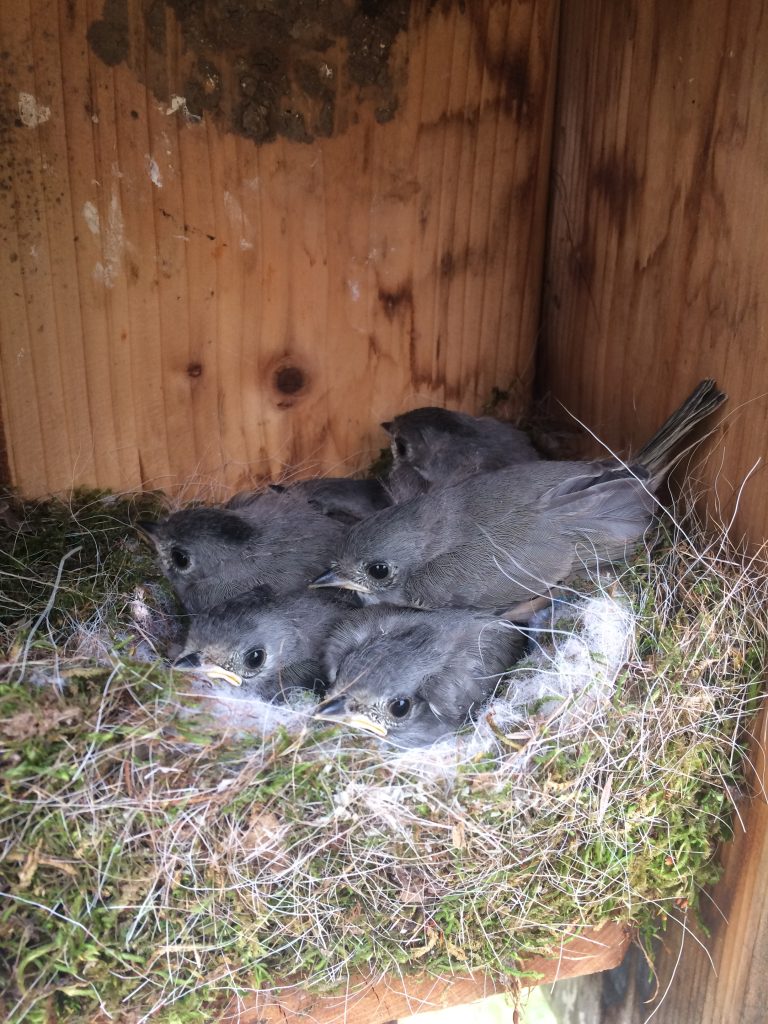
Introducing Glenda Beasley & Lanette Patterson
Plateau is happy to introduce our two newest employees, Glenda Beasley and Lanette Patterson. Glenda has stepped into the Director of Marketing role at Plateau and sister companies Braun & Gresham and Plateau Land Group. Lanette is the newest addition to our Ecological Services team as our Ecological Services Administrative Assistant.
Glenda Beasley
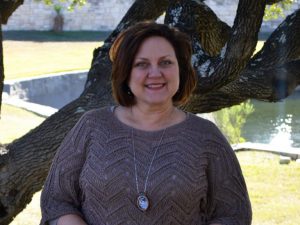 Glenda comes to the family of companies from a long line of Texas landowners as the descendant of Colonel Martin Parmer, aka The Ring Tailed Panther, a signer of the Texas Declaration of Independence from Mexico. Her father, Glenn Parmer, was in real estate for most of his career and is now a retired rancher, farmer and wildlife exemption participant in Caldwell, TX.
Glenda comes to the family of companies from a long line of Texas landowners as the descendant of Colonel Martin Parmer, aka The Ring Tailed Panther, a signer of the Texas Declaration of Independence from Mexico. Her father, Glenn Parmer, was in real estate for most of his career and is now a retired rancher, farmer and wildlife exemption participant in Caldwell, TX.
She has enjoyed a career ranging from local media sales to representing national media in multiple cities for Katz Media, to entrepreneur, to advertising and public relations firm owner to government and conservation marketing at Texas Parks and Wildlife Department. Along the way, Glenda and her husband Chef “Five Star” Ernie Beasley have invested in real estate, land, adventures with loved ones, travel, food, wine, music, gardening, their son Gray and an evil wiener dog named Carly.
The Beasley family is very excited to be a part of the Plateau and Braun & Gresham companies and looks forward to contributing to the short and long-term success and culture of the organization, and the clients they serve.
Lanette Patterson
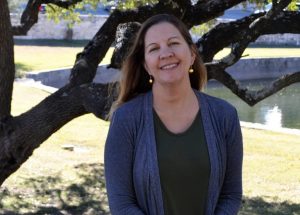 Lanette Patterson recently joined the Plateau team and provides administrative support to the Ecological Services team. Lanette has a deep love of Texas that extends to its wildlife and natural resources. Lanette grew up exploring the piney woods near the southern edge of the Big Thicket and nurtures a continuous appreciation for the Texas Hill Country since moving to the Austin area in the early nineties.
Lanette Patterson recently joined the Plateau team and provides administrative support to the Ecological Services team. Lanette has a deep love of Texas that extends to its wildlife and natural resources. Lanette grew up exploring the piney woods near the southern edge of the Big Thicket and nurtures a continuous appreciation for the Texas Hill Country since moving to the Austin area in the early nineties.
Lanette escapes to the Texas coast with her family as often as possible and indulges a passion for beachcombing that propels her on a never-ending quest for lightning whelks, sand dollars, and sea beans. She is also known to fish in Matagorda Bay from time to time. Lanette’s ever-expanding list of disparate obsessions also includes rolling tamales, designing and creating mosaic art, dabbling in oil painting, growing Hatch chile peppers, harvesting wild Muscadine grapes, and canning homemade jam. Lanette and her husband currently provide enthusiastic support to the Dripping Springs High School Band and Color Guard. Go Tigers!
Back to TopBack to Top
Service Spotlight: Site Monitoring Visit
By Kameron Bain, Business Development Manager
The New Year is a good time for a fresh start. And here at Plateau, that means checking and cleaning nest boxes. During the next few months, landowners should take the time to visit each nest box on their property in order to prepare them for the upcoming Spring birds. Don’t forget to document your work with a photo and a log sheet while doing so.
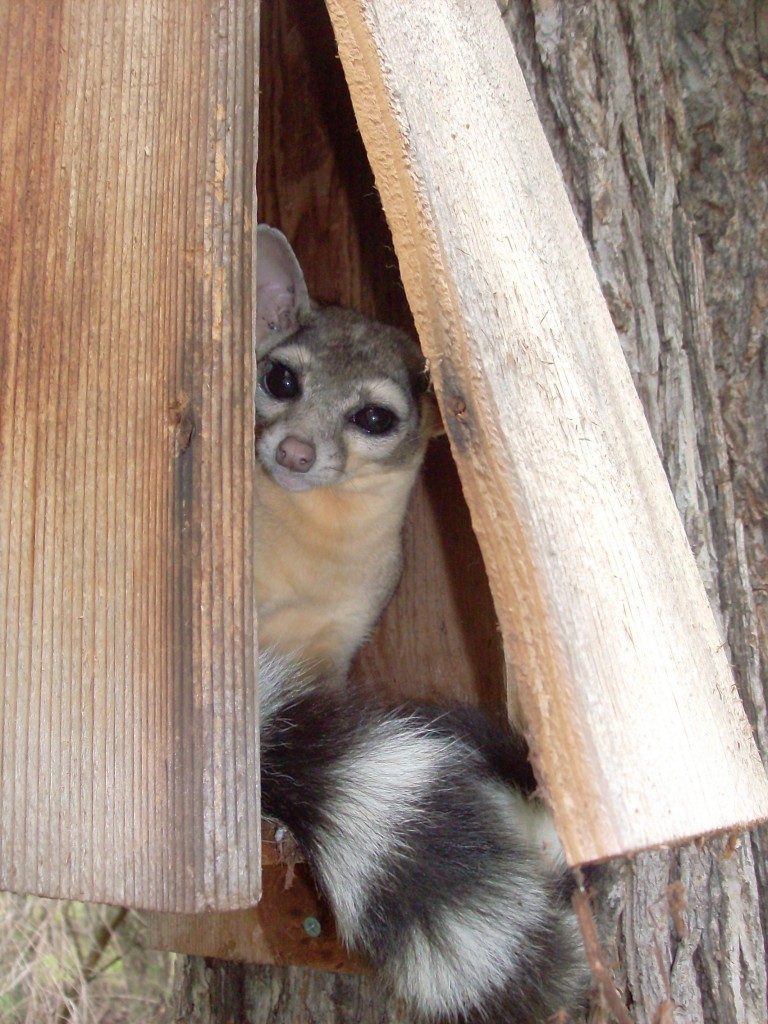
If you need help, a Plateau Site Monitoring Visit is just the right service to assist you in getting your wildlife management off to a good start in 2018. An Ecological Services Technician will inspect, monitor, test functionality and make minor repairs of all Wildlife Management Products originally installed by Plateau. Technicians will thoroughly document findings while on-site with notes and observations are recorded on filed log sheets and digital photographs are taken. All this documentation collected can be used as part of your yearly Annual Report. Base price starting at $175 plus $10 for each nest box.
If you’re interested in purchasing a site monitoring visit, give us a call at (512) 894-3479 or email us at [email protected].
Back to TopBack to Top
‘Tis the Season to Start Talking
By Margaret Menicucci, Attorney at Braun & Gresham, PLLC
My father passed away in 2010, after a long and meaningful life. Visits to my parents’ home were periodic because I live in a different state. In the last few years of his life, each time I visited, he would make me sit in his study and review his assets, his filing system, his meticulous records, and his plan for supporting my mother so she could continue to live at home after he passed. When he died, he left plenty of resources to support my mother comfortably. He also left a clear and effective will, beneficiary designations on his accounts, and guideposts in every file in his study that would help me help my mother manage those assets that are critical to her support and comfort. He taught me this powerful lesson about estate planning: an excellent estate plan requires good documents and records and meaningful communication of your goals and expectations with your loved ones.
In 2016, Fidelity Investments conducted a study focusing on the extent to which parents and their adult children communicate in depth about a range of financial and retirement topics. In the study group, 69% of the surveyed parents of adult children said they have had detailed conversations about their estate plans, but 86% of the surveyed parents said they had not had in-depth (or sometimes any) conversation with their children about long-term care and eldercare. The issues around eldercare and long-term care are especially sensitive and, at times, complex.
‘Tis the season to start talking.
Family visits in the next few weeks are prime time for discussions about parents’ long-term care and their legacy – how they want to pass their assets to family and their community. Certainly, an estate plan provides the critical tools for directing the care of aging parents and for distributing wealth when they die. A strong estate plan will include a Will or revocable living trust along with disability planning documents such as financial and medical powers of attorney and a health care directive. Our role as attorneys and counselors is to ensure that you and your family have the right tools to make the estate plan work. Communication among family members, however, provides that extra level of certainty that the estate plan will be implemented correctly and with respect for personal goals.
It may be too awkward to transition a conversation from football stats to medical powers of attorney. You will have more success with intentionally and honestly asking to set aside time for a discussion (not unlike my father bringing me into the study to review records). A request for time signals the importance of these conversations – this communication is about working together as a family to care for each other.
If adult children are starting the conversation, begin with high-level questions regarding goals and expectations and the ways you can help (not what is in it for you). You are there to learn and understand. Some starters could be:
- Mom, you have worked so hard to maintain the family ranch, what vision do you have for its future?
- Dad, if there comes a time when it is difficult for you to manage your investments and health care, what kind of assistance would you want us, as your children, to provide?
An August 2017 article in MarketWatch, an online news service published by Dow Jones & Co., provides more instruction about how to continue these conversations.
We have had clients come to Braun & Gresham for estate planning after they have handled the distribution of a parent’s estate. Those clients often tell us that the planning done by their parents, combined with their parents’ thoughtful communication of their wishes, was a priceless gift. It eased their minds, minimized sibling conflict, and helped expedite the probate process.
This season, a simple and priceless gift that you can give to your family is taking the time to talk about a parent’s estate plan (or need for one) and their expectations about retirement and long-term care.
If you have any questions or want to learn more about the estate planning process before or after the holiday season, please call Margaret at (512) 894-5426.
Back to TopBack to Top
What is Your Property Worth?
 Real estate is a specialty. Rural real estate is an even narrower niche, presenting various factual and contractual issues most people are not prepared to tackle. Most of the benefits offered by hiring a listing agent, such as market knowledge, familiarity with rural land ecology, property tax savvy, awareness of mineral, wind, and water rights, and pricing are obvious. Plus listing agents are experts at crafting a description and taking photographs of a property to show it in the best possible light.
Real estate is a specialty. Rural real estate is an even narrower niche, presenting various factual and contractual issues most people are not prepared to tackle. Most of the benefits offered by hiring a listing agent, such as market knowledge, familiarity with rural land ecology, property tax savvy, awareness of mineral, wind, and water rights, and pricing are obvious. Plus listing agents are experts at crafting a description and taking photographs of a property to show it in the best possible light.
However, did you know that it also takes a rural land expert to properly evaluate the value of your property? County appraisal districts often show the ag valuation of a property and competitive listings, and not the actual value. Plus, it is hard to find an exact competitive analysis as rural lands often offer different benefits from their neighbors. The rural land real estate experts at Plateau Land Group are focused only on rural property in Texas and are supported by the legal team of Braun & Gresham and the land and tax expertise of Plateau Land & Wildlife. See what your property is worth. Call (512) 829-5287 or email at [email protected] for a free estimate of your property value!
Back to TopBack to Top
Plateau Land Group Featured Listing
HR Ranch, Marble Falls, Travis County, TX, 146 acres for $2,920,000
 One of the most diverse properties in northern Travis County, HR Ranch is a hunter, equestrian, or investor’s dream. The property is expertly managed for whitetail deer and includes a 1,600 sf bunkhouse, 1,800 sf storage building with equipment, improved road system, four blinds, six feeders, and two historic grottos. A turnkey weekend retreat or a full-time homestead in the future, the HR Ranch is a rare opportunity to own a unique piece of the Texas Hill Country.
One of the most diverse properties in northern Travis County, HR Ranch is a hunter, equestrian, or investor’s dream. The property is expertly managed for whitetail deer and includes a 1,600 sf bunkhouse, 1,800 sf storage building with equipment, improved road system, four blinds, six feeders, and two historic grottos. A turnkey weekend retreat or a full-time homestead in the future, the HR Ranch is a rare opportunity to own a unique piece of the Texas Hill Country.
View all of Plateau Land Group’s listings.
Click here to receive PLG’s newest listings by email.
Back to TopBack to Top




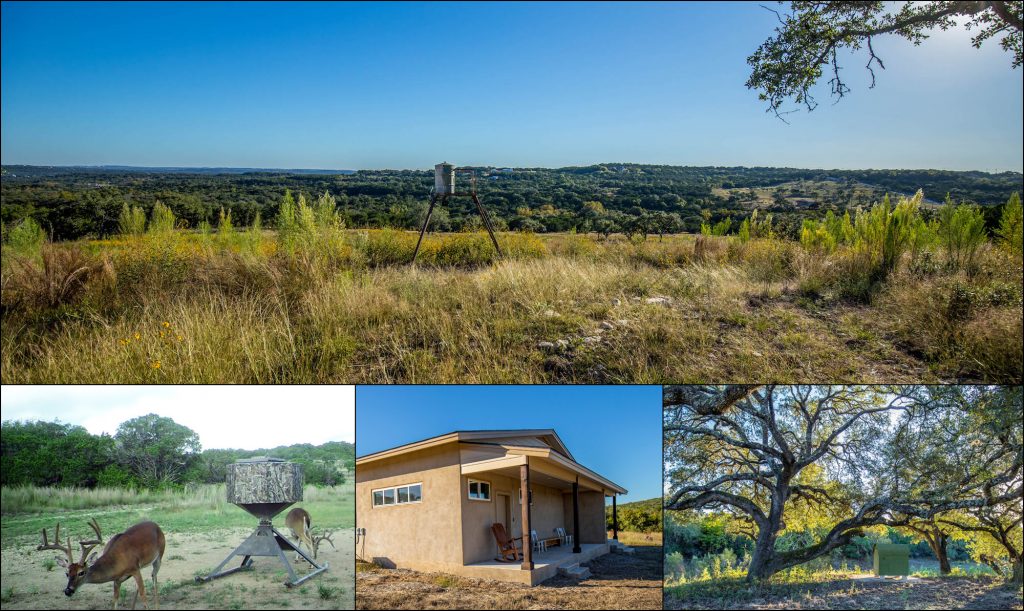



Sorry, the comment form is closed at this time.